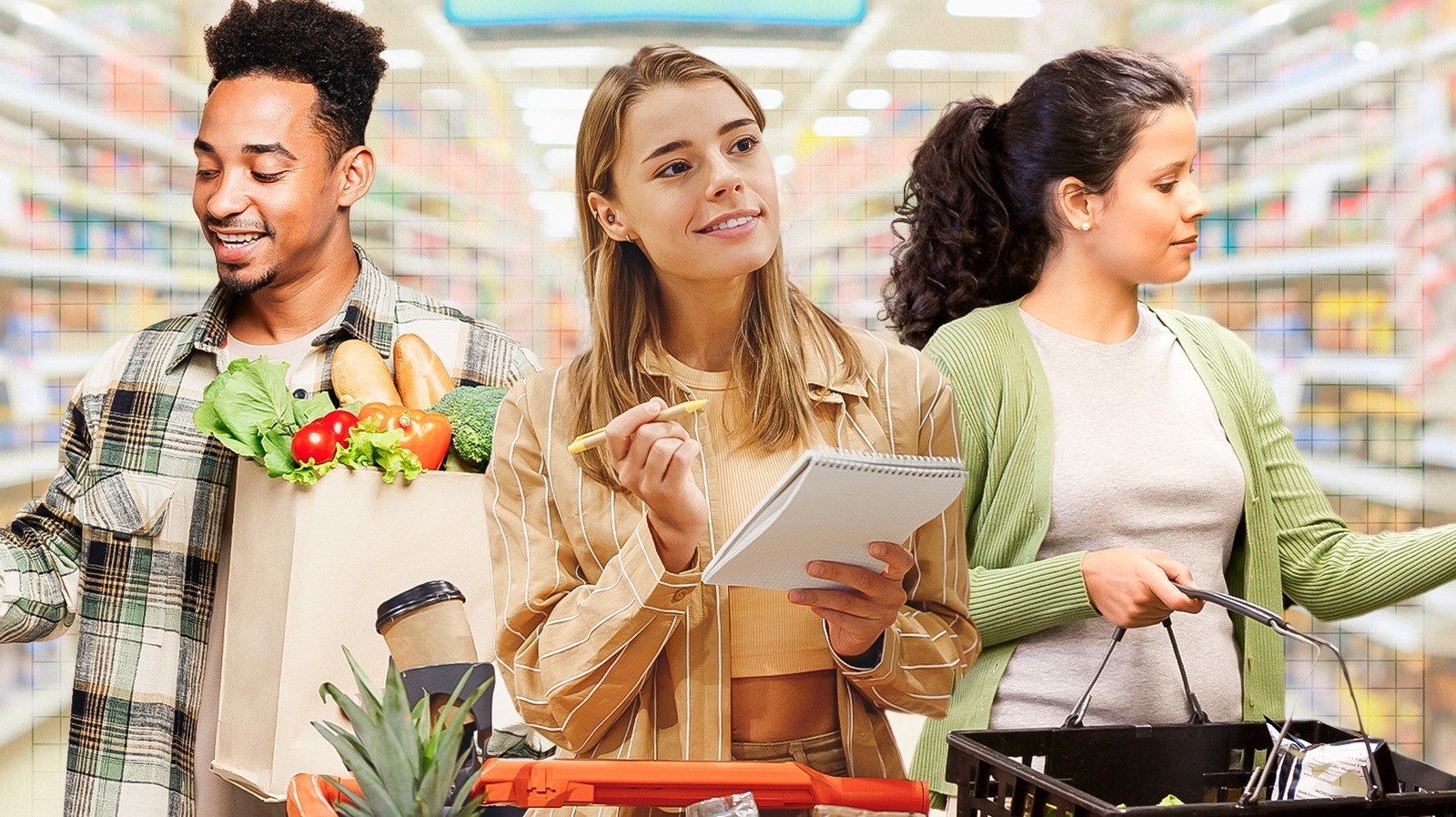Shopping
11 Expert Tips For Sustainable Grocery Shopping – Tasting Table

If you’re on a mission to lead a more sustainable lifestyle, your grocery shopping habits are a great place to start. After all, it’s easy to over-shop at the supermarket, especially if you live alone or lead a busy lifestyle. This can lead to wasted food, money, and time, along with greater impacts for the environment. Case in point: Food makes up a whopping 22% of waste in landfills, which is more than any other type of waste. Food packaging is also a major contributor of our plastic waste, further contributing to environmental pollution.
But not all hope is lost because it’s possible to reduce your own food and plastic waste. The key is to incorporate mindfulness, or the practice of being aware of our actions and thoughts, into your approach to grocery shopping. When you’re mindful of your habits, routines, and emotions around food and grocery shopping, you’ll be able to find opportunities to make more sustainable choices — and in turn, make decisions that are better for you and the planet.
Of course, you don’t have to make these changes overnight. It takes time and practice to adopt more sustainable shopping habits, particularly in the food space, where convenient plastic-wrapped items are so common. Start small and aim for simple, practical goals as you learn how sustainability can fit into your lifestyle. If you’re unsure where to start, consider the following mindful tips for sustainable grocery shopping, complete with insight and ideas from sustainability experts. Anne-Marie Bonneau is the author of “The Zero-Waste Chef: Plant-Forward Recipes and Tips for a Sustainable Kitchen and Planet.” Jackie Suggitt, vice president of business initiatives and community engagement at ReFED, a non-profit organization working to end food waste and loss across the U.S. food system.
Shop your kitchen first
Contrary to popular belief, sustainable grocery shopping doesn’t begin with the choices you make in the supermarket. Instead, it starts in your kitchen, where you can do a preliminary “shop” before heading to the store. This involves taking stock of the items in your pantry and fridge, allowing you to determine what you already have at home. From there, you can build a meal around these items, limiting how much you purchase at the supermarket and reducing food waste.
When shopping in your kitchen, check the most perishable food items first, says Anne-Marie Bonneau. This includes products like vegetables, fruits, dairy, meat, and cooked leftovers. With a bit of patience and imagination, you might find that you have everything needed to make a simple dish, like a curry, grain bowl, or frittata, says Bonneau. These meals are highly flexible, as they can be prepared with varying amounts of ingredients — i.e., whatever you have on hand. “By cooking this way, you’ll waste less food, buy less food, throw out less food packaging, and save money,” points out Bonneau. As a bonus, you might even find cooking more adventurous and enjoyable, she adds.
If you’re new to cooking or have a hard time creating meals from scraps, try using a recipe generator like SuperCook, MyFridgeFood, or DishGen. These tools suggest recipes based on the ingredients you have on hand, making it easier to build a meal.
Buy from the bulk section
For another way to practice sustainable shopping, buy your most-used dry goods from the bulk section of the supermarket. This can “help reduce packaging, particularly when you bring your own reusable containers,” says Jackie Suggitt. Examples of such vessels include fabric drawstring bags, glass jars, and clean takeout containers, although some stores might offer small brown paper bags. Likewise, shopping in the bulk section will help cut back on food waste, as you’ll be able to purchase only what you need for a particular recipe, notes Suggitt. For instance, “If you only need 1 cup of rice, you can buy just 1 cup [instead of] a 25-pound bag of it,” says Anne-Marie Bonneau.
However, not every town has a supermarket with bulk bins, so this approach might not be practical for your situation. In this case, it’s worth buying your most-used products in larger amounts, even if it’s packaged in plastic. For example, if “you eat a lot of rice, buying [a] 25-pound plastic bag of rice will overall packaging waste because one large bag will send less trash to the waste stream [compared to] 25 small bags,” explains Bonneau. Just be sure to store the product in sealed, airtight containers to keep it fresh for as long as possible.
Bring your own shopping bag
When a single-use plastic bag is tossed in the landfill, it can take at least 500 years to fully degrade, if at all. What’s more, pieces of plastic will break off the bag over time, creating microplastics that pollute the environment. Enter reusable bags, which can help you divert single-use plastic bags from the trash, creating a more sustainable shopping trip. This is especially true if you use insulated shopping bags, as they can keep cold and frozen food at the correct temperatures. From a sustainability standpoint, this is key for slowing down spoilage and preventing food waste, but it can reduce the risk of food poisoning as well.
Plus, some states and cities charge a small fee for plastic bags. The same can be said for paper versions, which might be available in regions where plastic bags have been banned. In either scenario, bringing your own bags will help you save money in the long run, as even small fees can add up over time. The trick, of course, is actually remembering to bring them to the grocery store. If you’re having a hard time adopting the habit, try keeping a few reusable bags by the door, near your keys, or in your car. It’s also worth buying a foldable shopping bag with a keychain, which will allow you to clip it onto your purse or backpack.
Shop local
Whether you’re picking out produce or shopping for honey, check where the items are from before adding them to your cart. This will give you a chance to discover products from local farms and businesses which are more sustainable than those shipped from far away. That’s because such items have traveled shorter distances to get to the store, which involves less gas and labor. This translates to fresher, longer-lasting products and ultimately, less food waste. Additionally, buying locally-grown fruits and vegetables supports local farms, which are more likely to practice sustainable farming techniques than their larger corporate-owned counterparts.
If you’re unsure how to buy more local food, start at the farmer’s market. Here, you’ll find plenty of fresh produce grown by farmers in your area. Depending on your region, you might also find locally-produced products like maple syrup, jam, eggs, and meat. Some farms even have storefronts where you can shop for groceries directly from the source. Other options include signing up for a community supported agriculture (CSA) program or shopping at a local food co-op. If these options aren’t available or you prefer to visit a big-box grocery store, take a moment to read product labels. Often, supermarkets will install signs to help customers identify locally-made products, so it’s certainly worth slowing down and checking displays when shopping.
Pick ugly produce
Choosing “ugly” fruits and vegetables is one of the most sustainable things you can do. But what counts as ugly produce, exactly, and why is buying them so good for the environment? “Let’s say you’re shopping for apples,” explains Anne-Marie Bonneau. “Most grocery stores [only] sell perfectly round apples of a uniform size. If anything falls outside of these parameters, sellers deem it ‘ugly.'” This might include apples with irregular sizes and shapes, for example. As a result, imperfect apples might not ever leave the farmer’s orchards, resulting in excess waste. And even if the ugly apples land at the supermarket, shoppers are more likely to skip them, increasing how much food the store has to toss. Thus, if you can buy ugly produce — apples or otherwise — you can keep that food out of the waste stream, says Bonneau. You might even be able to score a discount if you ask the cashier.
It’s important to note that ugly produce “tastes just like better-looking fruits and vegetables and have the same nutritional value; they just don’t look as nice,” says Jackie Suggitt. In fact, “according to ReFED, purchasing ugly produce at the grocery store has the potential to divert 1.5 million tons of food waste per year,” adds Suggitt. “If your local grocery store doesn’t stock imperfect produce, check out subscription-based models that sell these items directly to consumers,” she suggests.
Avoid plastic-wrapped produce
When you’ve got meals to cook and mouths to feed, it can be tempting to buy pre-washed, pre-cut produce at the grocery store. These options are convenient, no doubt — but they are extremely unsustainable. If you’d like to adopt a more mindful, environmentally-friendly approach, consider investing in reusable fabric produce bags. This way, you’ll be able to buy whole, package-free produce and skip the plastic wrapping. Granted, you’ll need to spend time cutting and preparing the food, but you’ll avoid plastic and save money, as more convenient options tend to be more expensive, says Anne-Marie Bonneau. The produce will also likely be fresher, ultimately reducing your overall food waste, she adds.
For another way to ditch plastic-wrapped produce, shop at farmer’s markets whenever possible. “Produce that travels long distances, sometimes in refrigerated containers on ships, is often highly packaged to protect it in transit,” explains Bonneau. On the other hand, produce sold at your farmer’s market comes from local farms, meaning they need to travel less distance. As a result, they’re often sold with little to no packaging and instead displayed loose and stored in bins, notes Bonneau.
Make a shopping list
Depending on your shopping style, preparing a list might seem like an extra task, especially if you usually buy the same products. However, it can be a game-changer for sustainable shopping, as the habit can prevent food waste and save money. When you have a grocery shopping list, you’ll know exactly what you need, making it easier to avoid overbuying food. This will prevent excess food from entering your kitchen, which is likely to spoil before you can use it. Shopping with a list also reduces the risk of impulse purchases and overspending, helping keep more dollars in your pocket.
To get the most out of your shopping list, try making a “master list” of items you regularly use. This way, you can easily remember what you need before creating a new list. While you’re at it, consider what type of produce is in season, as seasonal fruits and vegetables are cheaper and fresher, particularly if they’re from a local farm. From there, plan your meals and shopping list based on these items, along with the products you already have at home. By investing just a few minutes in your shopping list, you’ll be able to cultivate a more sustainable experience at the store.
Shop on a full stomach
Another tip for sustainable grocery shopping is to avoid shopping when you’re hungry. This habit requires a mindful approach, as it involves planning ahead. “When you shop hungry, you may buy more food than you can actually eat,” explains Anne-Marie Bonneau. This food has a higher chance of spoiling and going to waste, she adds. “Also, with your stomach growling as you cruise the aisle, you’ll want to eat as soon as possible; the siren song of ultra-processed convenience foods will [be] more likely to draw you in,” says Bonneau. Unfortunately, these foods are often heavily packaged in single-use plastic packaging, resulting in extra waste.
If you’re prone to buying random items while you’re hungry, don’t worry — it happens to the best of us, and it’s possible to tweak the habit. First, try to schedule your shopping trips after meals. If this isn’t possible, eat a quick snack before heading to the grocery store. This also takes some planning, as you’ll need to ensure you have snackable items on hand to begin with. Fruit like bananas and apples are excellent choices, as they’re travel-friendly, easy to prepare, and packed with satiated fiber.
Choose products in glass jars
When shopping for products like condiments or pickles, opt for products packaged in glass jars. Glass is entirely recyclable, as it can be melted and used to produce new glass containers. Plus, at home, you can wash and reuse glass jars to store food or other items. They’re also particularly useful for holding dry goods from bulk bins, as glass is airtight and impermeable. But wait — can’t you reuse plastic jars and bottles? Technically, you can, but plastic containers tend to be less sturdy than glass, making them more likely to end up in the trash.
When it comes to repurposing glass jars, it’s worth learning how to properly wash them and remove the labels. Luckily, it’s easy to do: Prepare a pot or large bowl of warm water, mix in a small amount of dish soap or castile soap, then add the glass jar. Make sure it’s completely submerged in the soapy mixture. Let it sit for 15 to 30 minutes or overnight or until the label slides off; the exact amount of time needed will depend on the adhesive. And just like that, you have a clean glass jar that’s ready to hold a variety of items.
Learn about food date labels
There’s nothing worse than grabbing food out of the fridge only to realize that the “best by,” “use by,” or “freeze by” date has passed. Understandably, you might assume the food is unsafe to eat — but don’t be so quick to toss it in the trash. Date labels are used to determine the quality, not safety, of food. This means consuming the dates on food packaging isn’t the best way to determine if it’s still good to eat. Moreover, “current date labeling practices on food packaging are inconsistent,” says Jackie Suggitt. This can prompt a great deal of confusion, causing many folks to discard food that’s still safe to eat, she says. In fact, more than 80% of people in the U.S. throw away edible food due to misunderstanding.
With that in mind, it’s best to use your senses — i.e., smell, taste, touch — to check if food is still fresh, suggests Suggitt. This can prevent you from tossing food that’s perfectly safe to eat, potentially lowering your own food waste. “If you still want to use the labels as a guide, organize your fridge and pantry to keep food with fast-approaching dates up front.” This will help remind you to eat the food before its quality declines.
Buy less meat
Shopping sustainably doesn’t stop at produce or packaged goods. It’s also essential to consider your meat consumption, as the production of meat — especially red meat like beef, pork, and lamb — is harmful to the environment. Beef production is the worst offender, as cows release greenhouse gases into the atmosphere, contributing to global warming and climate change. Not to mention, meat production requires a lot of energy and resources, making it less sustainable than plant-based foods.
If you currently eat meat, you don’t need to necessarily take it off your shopping list to practice sustainability. Consider swapping red meat for white meat, such as chicken or turkey, which produce less greenhouse gas emissions. Seafood produces even less, giving you a great reason to reach for salmon or tuna for dinner. Alternatively, if you still want to eat red meat, consider purchasing from a local farm that uses more sustainable farming practices.










